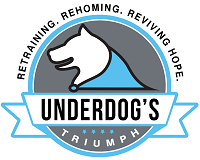
One of the most frequent cases that I get asked to help out with is help people with an aggressive dog. I’ll meet with those clients whose dogs are doing things like:
- Lunging at people/dogs/kids
- Barking at people/dogs/kids
- Biting people/dogs/kids
Reading these behaviors here, on paper, you know right away that those are serious issues. But oftentimes, and even I’m guilty of this, we soften the words we use to describe those actions. We say, oh well she “just nipped” or “snapped” or was “too excited.” It’s sad to say that many folks only seek out a dog professional only AFTER a major incident has happened, and by then you’ve definitely got a long road of training ahead of you.
But there’s another side to this, which I hadn’t ever considered before. A lot of trainers talk about how they “rehabilitate aggression” and I think this confuses the issue even further. When we talk about “aggression” we’re talking about an emotional response the dog is having to a given stimuli. And then those trainers are suggesting that we somehow “cure” this emotion.
That seems silly to me. You can’t stop someone from feeling an emotion. If jump out of you and shout BOO you experience fear. I can’t somehow magically get you to stop feeling that emotion.
I think adding the “rehabilitation” bit in front of vague term “aggression”, might suggest to the client that once they’ve completed the training their dog is “cured.” They’ll no longer have to worry about the dog and he or she will be bomb proof in any situation. All those behaviors you’ve seen before are now “fixed” and you can carry on like nothing has ever happened.
That’s just unrealistic. Dog trainers and behaviorists should instead seek to change the reaction your dog has to those emotions. It’s 100% fine if your dog feels frustrated about something, but what we want to help him or her learn how to appropriately react to that emotion. Instead of barking and lunging at the thing that scared you, how about instead you turn away from that thing and walk away from it.
That puts the ball back into our (human) court. We help teach the dog that when he or she does the desired reaction when experiencing some sort of emotion, the new desired outcome is better than their previous behavior. We can accomplish this by controlling the reward in that situation as well as better understanding what motivates that individual dog.
Controlling and understand motivation is key to getting the desired behavior. If your dog is scared of something, some are motivated by just getting away from that thing (aka motivate by gaining distance), others get rewarded by investigating that thing until they know what it is (motivated by investigation/smelling). Knowing which motivator works for your dog can mean the difference between success and failure. If I drag my distance driven dog right up to the thing he or she is terrified of, no one wins.
To me aggression is an emotion, not a behavior. We can’t fix aggression. We can however treat reactivity, which is the behavior we see. We can change how the dog response when he or she experiences an emotion. We can teach them to resist impulses or to avoid things (or investigate) things that scare them. They’re all just skills.
For those interested in learning more about reactive dogs and training methods. I picked up this awesome little book called BAT 2.0 – Behavioral Adjustment Training on Amazon for ~$20 – http://a.co/0bWl8Ra It’s been a super interesting read about addressing “aggression”, more appropriately named reactivity.
You can also read a great article written by 4Paws University on Facebook for more details too. https://www.facebook.com/4pawsuniversity/photos/a.137573622069.109578.49741042069/10154375851132070/?type=3&hc_ref=ARQauXEJh3hCPCBaK2eIG7JfqKaIxnfg7ZkHZGBofcv8GMJNsqFf9eh_K9AQRQIInMM
